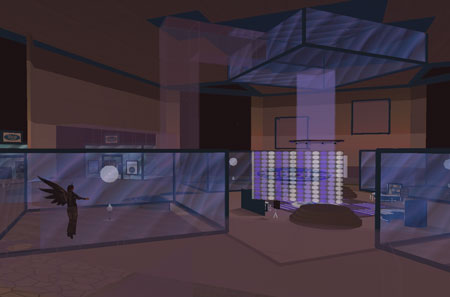Originally published Oct 2011 in Wired Magazine ‘Change Accelerators‘ by Gary Hayes
Grab some nibbles, pour yourself a drink, and sit down. You’re now ready to immerse yourself in a TV show. And then you notice that CSI Miami is placing Facebook photos of your aunt, uncle, and cousins onto the desk of a perp. Lean forward, and keep your eyes peeled, updates from your Facebook page are about to be incorporated into your favorite TV show’s narrative. (Your best friend becomes the suspect!) As you immerse yourself in the story, the story immerses itself in your social world. In this context, online meets offline and your family and friends will never look the same again!
While this opening scenario sounds like pure fantasy, it’s not. It’s actually based on Warner Brother’s Aim High, an upcoming web series that will integrate pictures, music, and information from a viewer’s Facebook page into the video. One might call it the ultimate transmedia vanity blockbuster, where viewers are watching and playing with their own distributed, but connected story fragments. If this trend continues, soon we’ll be interacting with TV and games mashed up with our own social networks on big and small screens everywhere.
Since 2003, tools that allow people to easily create, upload, and share personal content are now commonplace. With so many people sharing their lives through networks, there is a social story revolution unfolding. There are more photos taken every two minutes today than during the entire 1800s and, as my Social Media Counter shows, most of this new content is created by individuals who used to be called the audience.
Since the late ’90s, the vision of interactive TV has been to meld this viewer-generated content into shows, particularly live TV. Today, we are taking the greatest evolutionary steps in broadcasting since the advent of live TV. In my presentation, “The Gamification of Social TV,” I examine the ways audiences are becoming more and more integrated into media, such as shows, films, games, and live events; first, there is the social level, then the participative, and finally, the inclusive.
Real-time conversation about what’s happening on TV has pretty much been with us since the beginning of mass TV in the ’50s. However, nowadays we have advanced well beyond the cord-tethered telethons of yesteryear. Today, advanced technology, like text voting, allows shows to measure the sentiment of the crowd sitting at home, not just the studio audience, in real time.
Andy Warhol famously predicted, “In the future, everyone will be world-famous for 15 minutes.” That future has arrived: We can all be stars in our own lifetimes, even if it’s just among our social network. We have become our own entertainment hubs, around which our friends and media circulate. Broadcasters and service providers have caught on to this trend, and now, entertainment-based social networking websites, like GetGlue, allow viewers to check in to movies, TV, and music. These personalized hubs fueled by recommendation and loyalty are allowing viewers to lock their worlds to TV space.
Not surprisingly, marketers are also taking notice of the advantages presented by social storytelling. A recent example is the Rommy Gulla Facebook video campaign run by Panasonic Australia. To demonstrate a new Blu-ray recorder’s ability to store 28 full days of HD content, the company developed a Truman Show-esque, promotional Facebook campaign encouraging input and social sharing.
Other online services, like Hulu, are also allowing users to bring media directly to their networks and take root inside Facebook itself, creating a forum for friends to share video content seamlessly. At the other end of the spectrum, there are options like Beckinfield Mass Participation TV, which takes social media to the nth degree by inviting users to film themselves as the stars and extend the web show format. This concept borrows from the realm of social alternate reality games, such as a World Without Oil, Truth About Marika, or Conspiracy for Good, which have been allowing users to write themselves into scripts and become the activist hero for quite some time now. Social media storytelling has deep roots in multiplayer role-playing gaming; in fact, the fastest growing game on Facebook at the moment is Sims, the $4 billion franchise game, where players inhabit and merge with social experiences in an alternate character-driven world.
Is alternate character acting the future? The film industry is not far behind in embracing social films. Earlier this year, Toshiba, Intel, and their ad agency Pereira & O’Dell took a gamble onInside, an interactive film experiment starring Emmy Rossum directed by D.J. Caruso. Now some people are speculating about whether or not social films are the next big thing in Hollywood. Will we see a social film revolution where plot dilemmas are handed over to the audience to experience and solve?
When it is done well, traditional storytelling married to social media is very powerful: It takes those people who want to go beyond a behind-the-scenes DVD extra into the story. While we watch to see if integrated social media entertainment will really take off, there are still some issues to consider, such as, is it invasive for characters from shows to enter an individual’s social networks? and Can a TV blockbuster become too personal?
That said, for now, I’m off to watch an episode of House, where I’m the patient!






Personalized Entertainment – Social, Transmedia Storytelling – Beyond 2012 Wired t.co/ptJuap6e
Personalized Entertainment – Social, Transmedia Storytelling – Beyond 2012 Wired t.co/ptJuap6e
Personalized Entertainment – Social, Transmedia Storytelling – Beyond 2012 Wired t.co/ptJuap6e
Personalized Entertainment – Social, Transmedia Storytelling – Beyond 2012 Wired t.co/lZbLeCoz
Personalized Entertainment – Social, Transmedia Storytelling – Beyond 2012 Wired t.co/ptJuap6e
Personalized Entertainment – Social, Transmedia Storytelling – Beyond 2012 Wired t.co/ptJuap6e
Personalized Entertainment – Social, Transmedia Storytelling – Beyond 2012 Wired t.co/ptJuap6e
RT @garyphayes: Personalized Entertainment – Social, Transmedia Storytelling – Beyond 2012 Wired t.co/qrmVeJV1
Personalized Entertainment – Social, Transmedia Storytelling – Beyond 2012 Wired | PERSONALIZE MEDIA t.co/AhczmeDa
Personalized Entertainment – Social, Transmedia Storytelling – Beyond 2012 Wired | t.co/zMPQbgAr
Personalized Entertainment – Social, Transmedia Storytelling – Beyond 2012 Wired | t.co/x5n1Q7Fk
Personalized Entertainment – Social, Transmedia Storytelling – Beyond 2012 Wired – t.co/VIFJCjBa
Personalized Entertainment – Social, Transmedia Storytelling – Beyond 2012 Wired | t.co/BRlC1NOr
Personalized Entertainment – Social, Transmedia Storytelling – Beyond 2012 Wired | t.co/tKDo5alt
RT @garyphayes: Personalized Entertainment – Social, Transmedia Storytelling – Beyond 2012 Wired t.co/y1Eh0cZn
Transmedia storytelling. t.co/WFZTaMCm
Transmedia storytelling. t.co/WFZTaMCm
Personalized Entertainment – Social, Transmedia Storytelling – Beyond 2012 Wired t.co/ptJuap6e
Interesting article. Personalized Entertainment > t.co/lN9u0ln9
Interesting article. Personalized Entertainment > t.co/cZJI47AU
Interesting article. Personalized Entertainment > t.co/BtoyghIZ
… we are taking the greatest evolutionary steps in broadcasting since the advent of live TV. t.co/pW1ZTuZI @ChrisMolina6 #socialtv
… we are taking the greatest evolutionary steps in broadcasting since the advent of live TV. t.co/pW1ZTuZI @ChrisMolina6 #socialtv
Interesting article. Personalized Entertainment > t.co/BtoyghIZ
"Updates from your Facebook page are about to be incorporated into your favorite TV show’s narrative" t.co/WuP3k6TZ @garyphayes
RTgaryhayes #Augmented Reality #Divergence #Mixed Reality Revolution #Storytelling2.0 #Transmedia
t.co/Xc8v6nFX
RTgaryhayes #Advertising #AugmentedReality #Divergence #MixedRealityRevolution #Storytelling2.0 #Transmedia
t.co/Xc8v6nFX
RTgaryhayes #Advertising #AugmentedReality #Divergence #MixedRealityRevolution #Storytelling20 #Transmedia
t.co/Xc8v6nFX
Archive: : Personalized Entertainment – Social, Transmedia Storytelling – Beyond 2012 Wired t.co/RJZU3shf
Archive: : Personalized Entertainment – Social, Transmedia Storytelling – Beyond 2012 Wired t.co/RJZU3shf
He took the words out of my mouth! "All the worlds a stage!" t.co/Pwm9EDhC #plasticmedia #15MEGs #transmedia @GaryHayes
He took the words out of my mouth! "All the worlds a stage!" t.co/Pwm9EDhC #plasticmedia #15MEGs #transmedia @GaryHayes